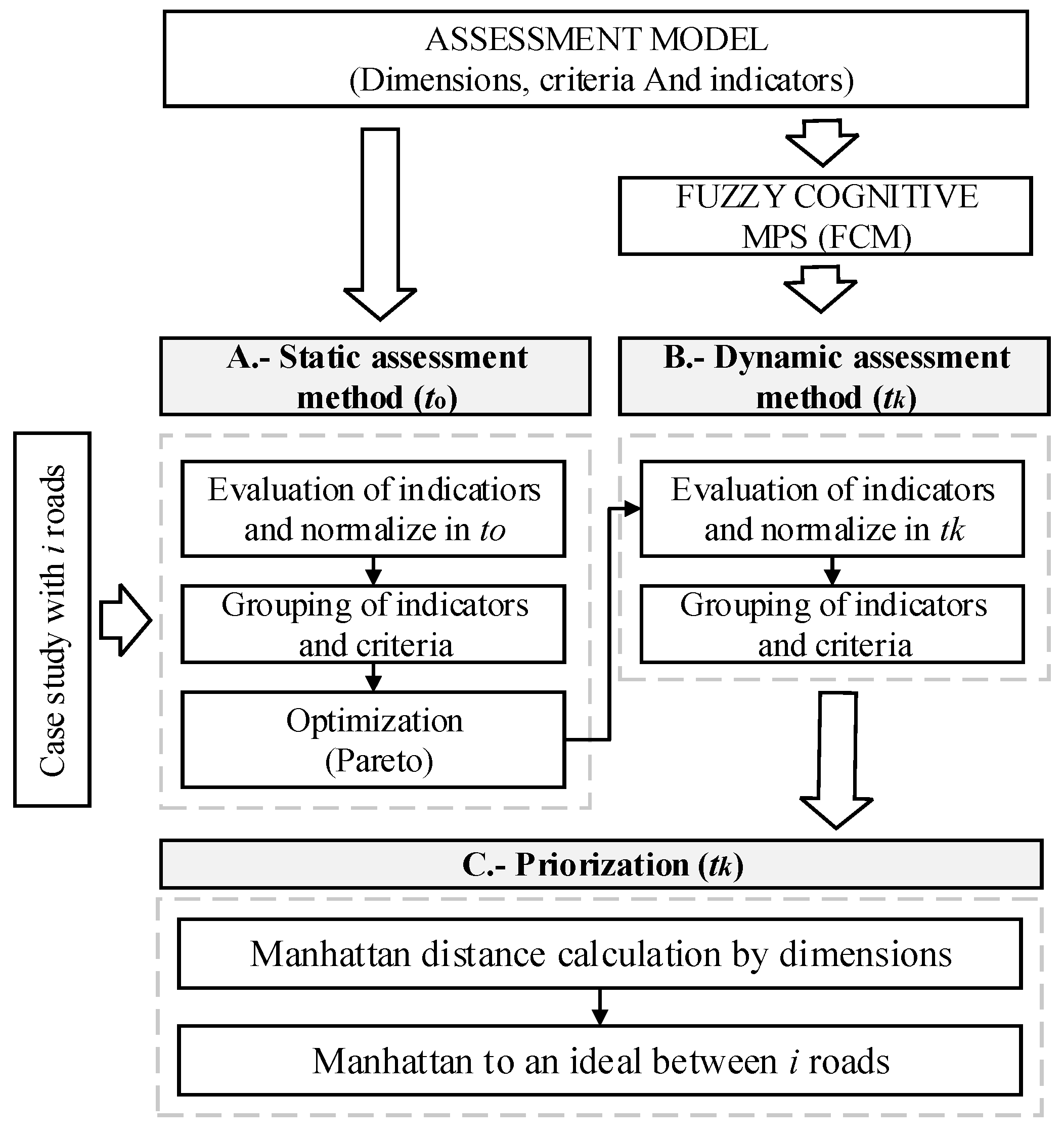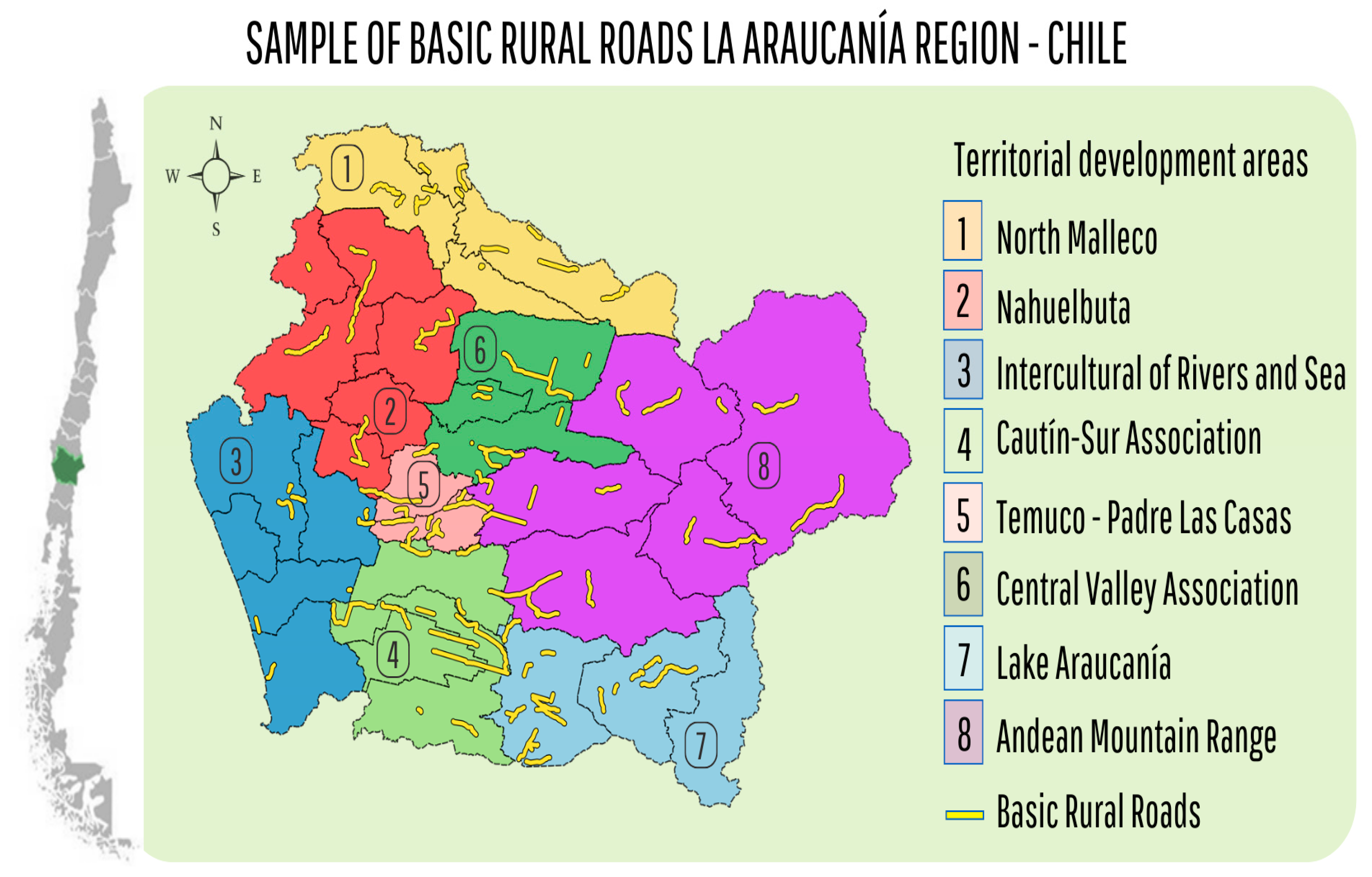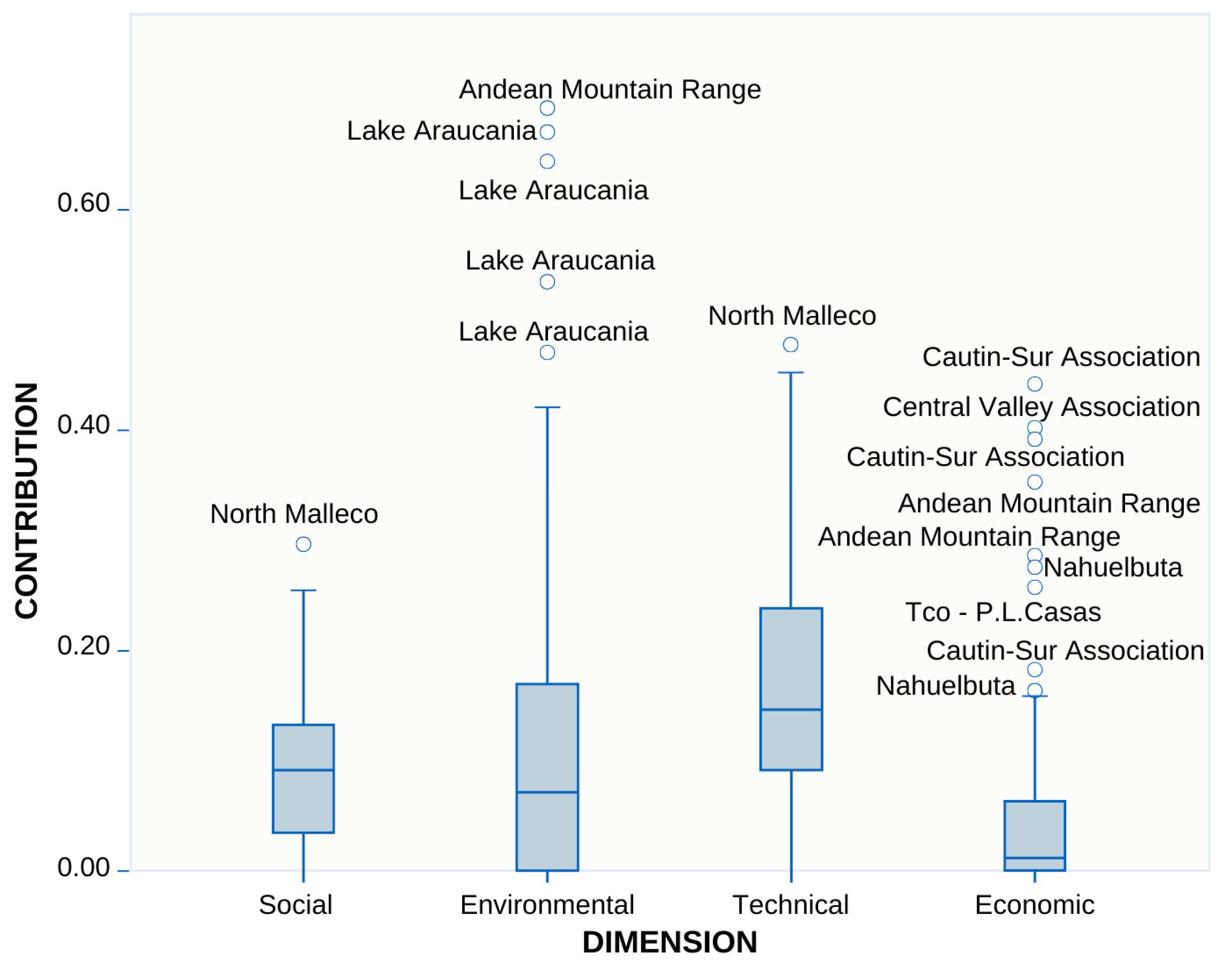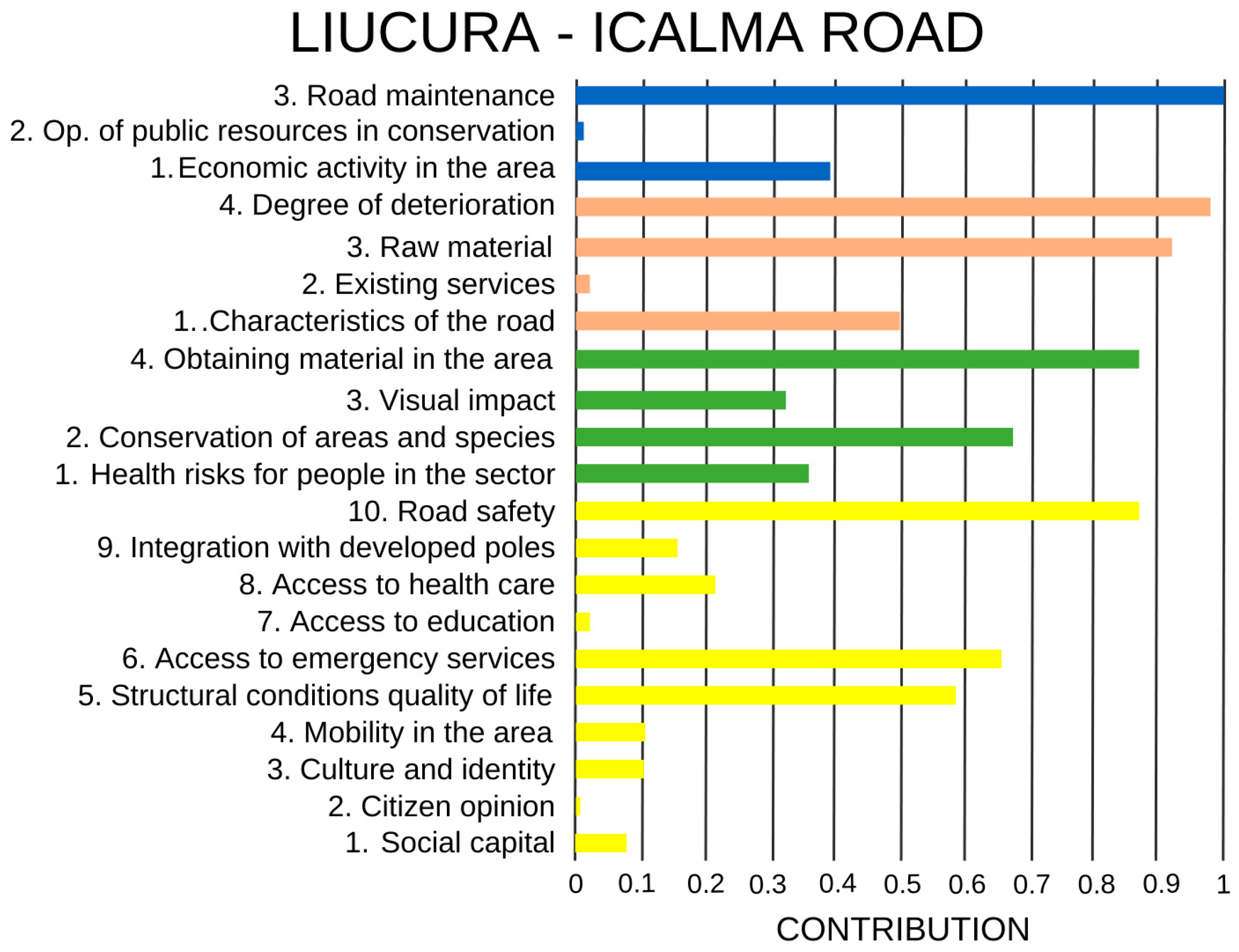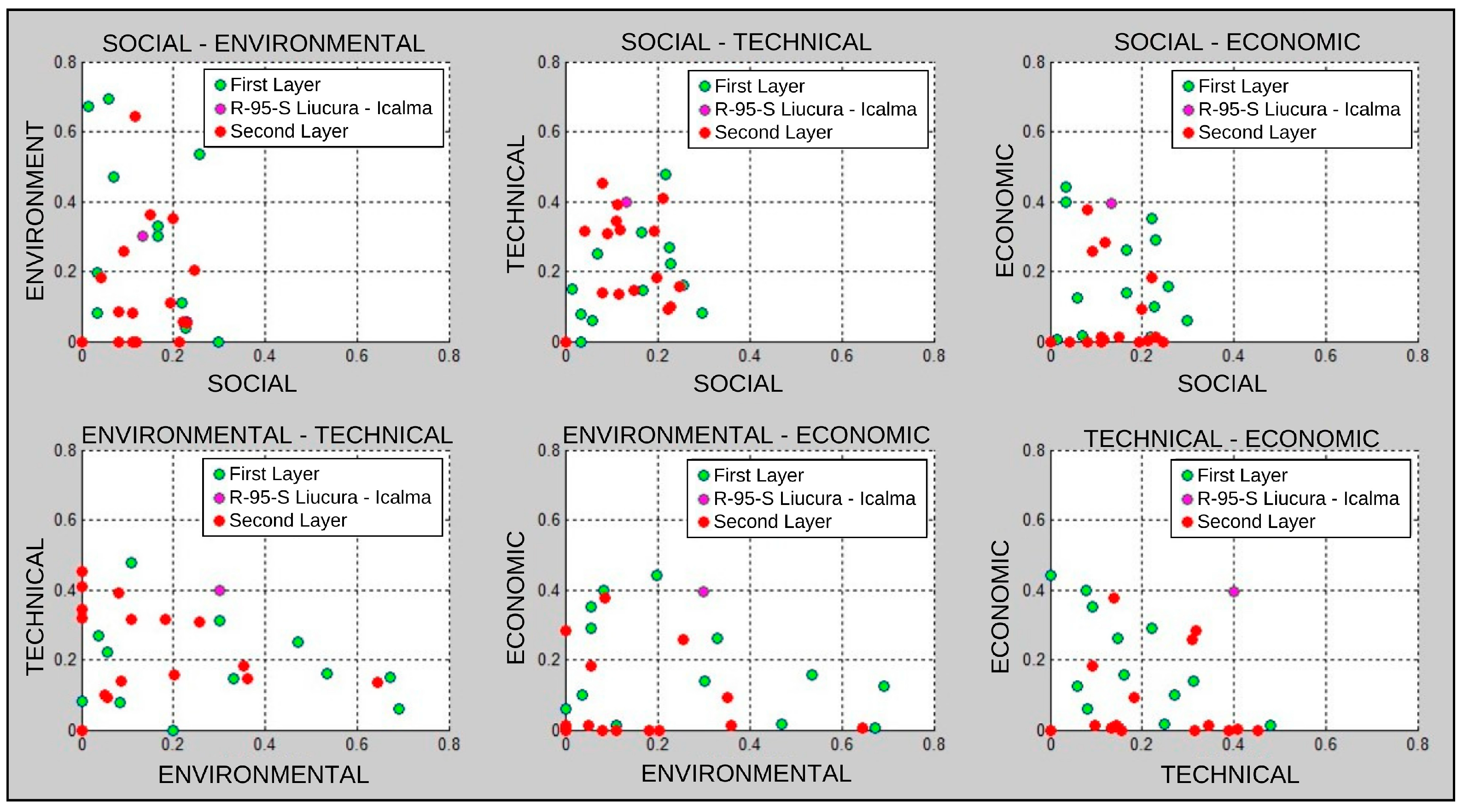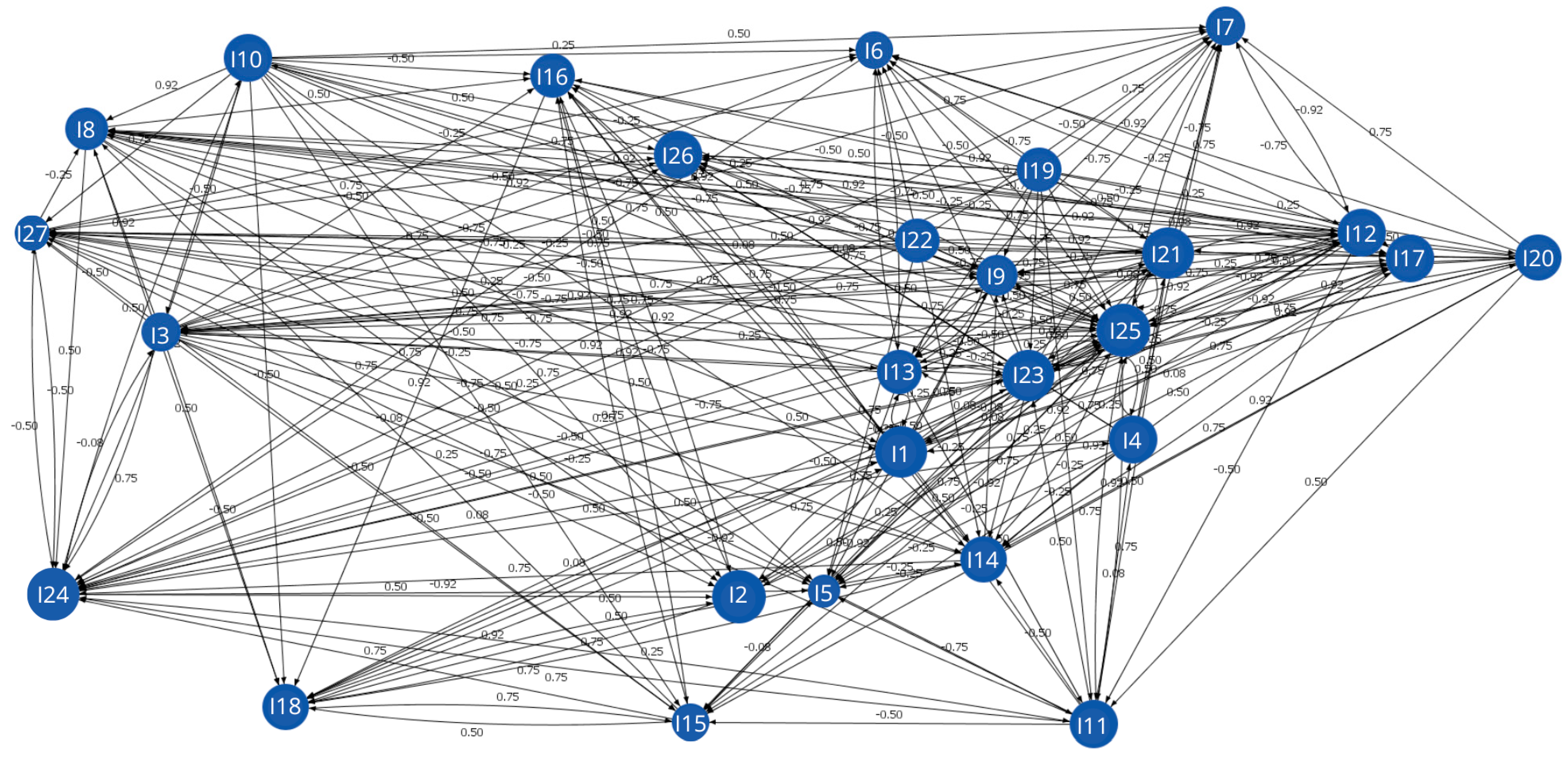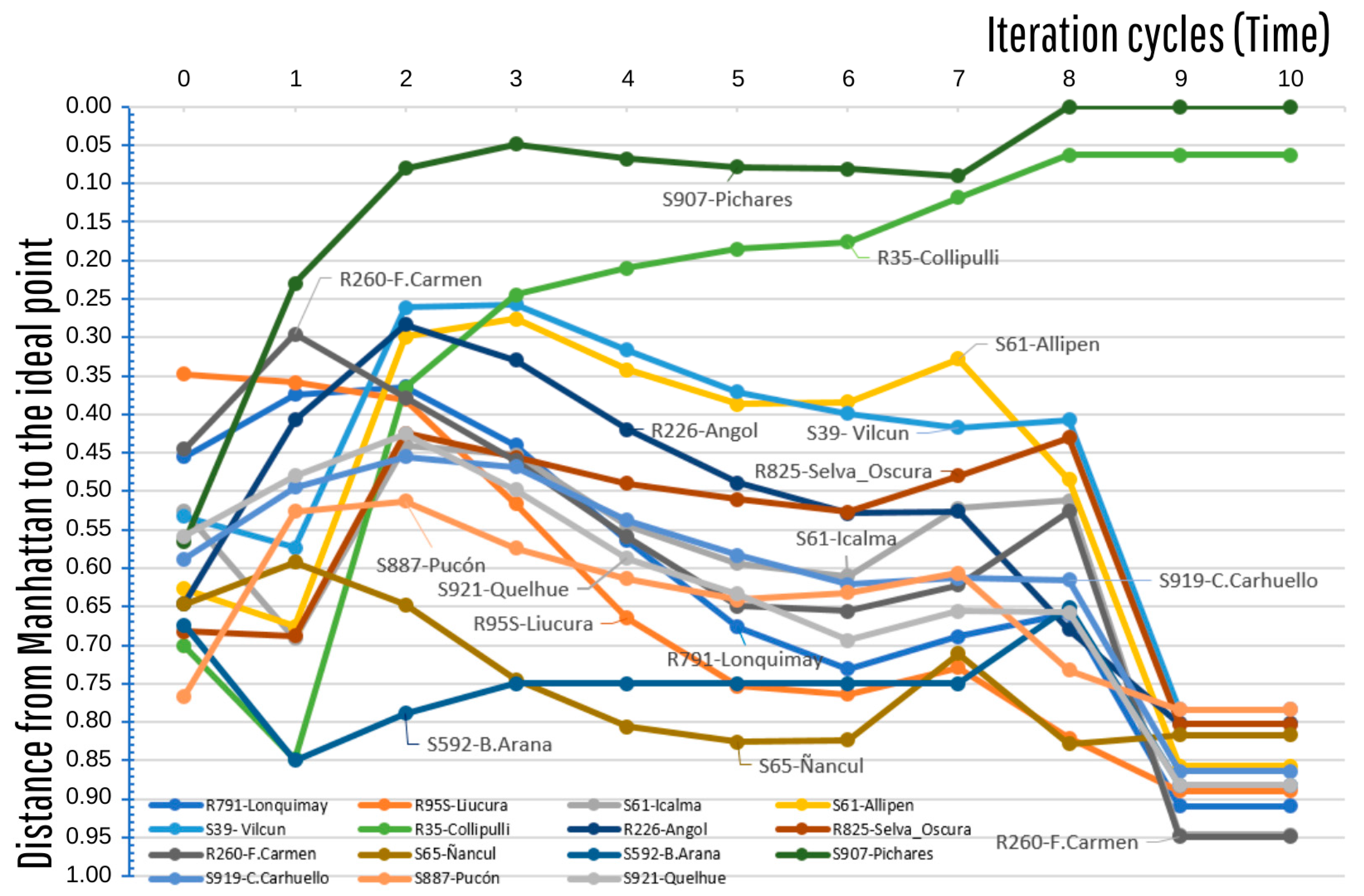1. Introduction
In Latin America, the rural sectors are highly vulnerable even when the development policies and public budgets are secondary to urban development. Some conditions that originate and aggravate the rural vulnerability are the lack of access to education, health, and markets [
1]. In this sense, rural roads play a crucial role in the development of society. Rural development depends on the interaction and simultaneous improvement of the rural infrastructure, productive sectors and economic services, and natural and social habitats [
2]. Even road access can compensate for the lack of other public and private assets [
3]. Thus, road infrastructure investment decision making is crucial for the sustainable rural development of a territory and is not sufficiently considered [
4,
5,
6].
Since 2023, Chile has had a network of 88,210 km of roads, 52.8% of which are still dirt or gravel roads. The Araucanía, Los Ríos, and Los Lagos are the regions with the greatest deficit of paved roads in the country [
7]. In this regard, the Basic Roads program for road improvement was established in Chile in 2003, aiming to provide conservation resources from the Chilean Ministry of Public Works (MOP) for roads that typically lack the traffic demand to warrant investment. However, this resource allocation has neither defined, clearly measurable criteria nor an evaluation structure that objectively defines its contribution to the rural territory [
8]. Rural development adheres to a comprehensive array of interrelated factors inadequately recognized to inform sustainable decision making. Indeed, rural infrastructure prioritization and evaluation in Latin America do not conform to the conventional patterns of national public infrastructure investment systems based on cost–benefit analyses [
1]. In this case, monetary terms and time-saving factors lose meaning in rural contexts. In addition, cultural and social factors, which are important, are not usually included in the traditional systems [
9]. In this context, Chile’s Basic Roads program has constructed over 15,000 km, resulting in an enhanced quality of life for local residents, decreased transportation expenses, diminished pollution, improved driving comfort, increased access to scenic areas, the promotion of rural tourism, and advancement of local development [
10].
Sustainability is a multidisciplinary science with a holistic approach that integrates all the interconnected issues [
11]. In such instances, evaluating the sustainable factors must align with the social, cultural, and socioeconomic needs while preserving the environment and adhering to technically viable solutions. Diaz-Sarachaga et al. [
12] propose that sustainable development should involve an integrated system of social, economic, environmental, and technical variables. In this context, a set of evaluation criteria related to the contribution of rural roads to territorial sustainability has been proposed [
13]. Through a set of multidisciplinary specialists and neutrosophic logic, 23 criteria have been determined based on a set of rural roads in the region of La Araucanía, Chile. These criteria form the assessment model for this article. However, in addition to an assessment model, a mechanism is required to represent the contribution of rural roads to short- and long-term territorial sustainability. In this sense, there is an international tendency to prove methodologies for evaluating ecosystems oriented to climate change and mitigation policies focused on protecting ecosystems [
14]. In this line, [
15] proposed a mechanism to localize natural solutions based on the demand for ecosystem services in urban areas. Likewise, [
16] provided the relevant information to include selection mechanisms that condition the healthy design of rural and urban environments.
Specifically, some authors have proposed mechanisms for assessing the sustainability of infrastructures. Zhou et al. [
17] determined the sustainable development of rural roads using the entropy method. The study focused on the short-term contribution to sustainable agricultural development in provinces in China. Singh et al. [
18] focused on the direct and indirect socioeconomic impacts of rural roads in India. Using a dataset, they implemented a georegression and principal component analysis. In addition, some Sustainability Rating Systems like ENVISION, CEEQUAL, or IS are methods that precondition scores or credits based on the compliance with sustainability criteria. In these cases, the context is defined as a standard, and neither participation nor external variables that modify the contribution to the lifecycle of the infrastructure are considered [
12]. In professional practice, the cost–benefit analysis is a conventional method for infrastructure assessment. However, it presents difficulties when dealing with non-monetary externalities and does not allow participation in the assessment process [
19]. Life cycle assessment (LCA) is a methodological structure with a recent development, which requires a database or inventory for its operation [
20]. In addition, databases have been proposed to complement the method, such as the “social hotspot” that expresses the social risk by country and productive sector. However, currently, the information in these databases only integrates some developed countries, has an associated cost, and becomes difficult to extrapolate to specific contexts [
20].
Multicriteria methods are most commonly used to assess projects in a multidimensional and participatory manner [
19]. These methods make it possible to deal with aspects of a different nature (quantitative and qualitative), to interconnect them, and to complement them with other appropriate techniques to obtain the best representation of each variable. This methodology reports studies utilizing multicriteria methods to prioritize the improvement of rural roads, focusing on poverty alleviation, maintenance, and technical and safety considerations in the short term [
21,
22,
23]. Using multi-criteria methods, other authors have selected pavement types in the consideration of the physical and environmental characteristics of roads [
24]. Krajangsri and Pongpeng [
25] formulated a multicriteria model of sustainable infrastructure assessment applied to four rural roads. The model is based on a utility and social welfare function considering the interests of various stakeholders, the uncertainty of the evaluation process, and the local context. Furthermore, multi-objective methodologies and distance studies have optimized and prioritized infrastructures that fulfill non-tradable sustainable objectives, thereby avoiding compensation [
26,
27].
Up to this point, multi-criteria methods and their complements have been efficiently used to represent the multidimensional variables; however, the interconnection of factors and a paucity of information influence the adequate estimation of the sustainable contribution of roads in the territory, and this requires additional treatment for their adequate representation. Throughout a road’s life cycle—encompassing design, construction, and operation—utility, perception, and technical advancements influence the societal value attributed to sustainability variables, which are deeply integrated into the context [
28]. In this sense, sustainability variables are not independent of the effects of the other social, economic, environmental, or technical variables that arise in a project’s life cycle [
29]. Moreover, the lack of information in rural contexts constrains decision making and methodological applications. In this sense, participatory processes can contribute to the construction of logic models based on soft systems that explain the impacts in rural contexts [
26,
29,
30,
31,
32]. Thus, an alternative is fuzzy cognitive mapping (FCM). FCM is a graph theory-based mechanism compatible with soft computing systems and neural networks. FCMs help capture and operationalize the dynamic interactions within a context involving its key actors [
33,
34]. These models have demonstrated efficacy in configuring parameters with restricted database access while analyzing the dynamic effects of construction project management and the sustainability assessment of urban infrastructures [
35,
36].
Up to this point, a conceptual model of criteria delineates the contribution of rural roads to territorial sustainability; however, the mechanisms for estimating both the current and long-term contributions require further investigation, which is the gap to address in this paper. In this sense, two starting points are synthesized. First, multicriteria and multi-objective techniques are a starting point for operating a model that represents the dimensions of sustainability [
23,
26], even when it is necessary to incorporate the dynamic effects of the causal relationships among social, economic, technical, and environmental variables to determine the interactive behavior of sustainability [
29]. Second, a fuzzy cognitive model can represent dynamic behaviors, overcoming the difficulty of accessing quantitative databases through participation [
33]. Consequently, this study proposes a mechanism for assessing and prioritizing rural roads that must be the subject of project development, considering their static and dynamic contributions to territorial sustainability. Based on the above, the following sections present the specific methods and procedures used to develop the proposed objective. Next, the case study used to implement the process is described, as well as its partial and total results. Finally, a discussion and conclusions are presented.
2. Materials and Methods
This paper presents methodologies to assess the static and dynamic contributions of roads to sustainable territorial development. This mechanism requires the support of a multi-criteria assessment model determined by the context conditions, the characteristics of the type of infrastructure, and its location. From this model, a static (A), dynamic (B), and prioritization (C) evaluation mechanism can be derived. The static method involves a series of indicators and weighted hierarchical criteria to assess the contribution of each sustainability dimension (environmental, technical, economic, and social) at a certain moment (
t0). The dynamic technique accounts for the causal relationships among each of the indicators. This makes it possible to calculate the progressive effect of interactions at each time
k due to some indicators’ effect on others, from static initial values and an optimized set of roads. Based on the dynamic behavior, the indicators are processed in each
tk to prioritize the selected roads according to their distance to an ideal and to determine their time behavior.
Figure 1 illustrates the evaluation method proposed by the authors, which is consistent with steps A, B, and C.
Figure 1 indicates that a case study is required to develop the static assessment. This case study is defined by a database that facilitates the responses to an indicator set of an evaluation framework with “i” roads. The database of rural road indicators for the Araucanía region, as proposed by Sierra [
37], is referenced. From this information, the normalized indicators are aggregated by criterion and dimension consistent with the weights proposed by Sierra et al. [
13] and the multi-criteria SAW technique [
38]. With the contribution to each sustainability dimension, a multi-objective optimization is implemented for the set of roads in the case study. Employing the Pareto optimal technique allows for the refinement of the set of roads to those efficient infrastructures that ensure that no alternative road exists that enhances one dimension without compromising at least one other dimension [
39].
At this point, it is necessary to configure an FCM that arises from the indicators of the assessment model and a panel of multidisciplinary specialists. In this model, the cause–effect interrelationship between indicators is determined. FCMs are soft computing techniques that combine fuzzy logic and neural networks. This technique simplifies a complex decision environment while integrating the different stakeholders’ perspectives through a semi-quantitative approach with incomplete and vague data [
40]. Thus, a network is represented in which each node illustrates the normalized value [0,1] of an indicator at
t0. The indicators are interconnected with fuzzy weights between [−1 and 1], representing the strength of a causal relationship and the meaning of the impact. The weight of the relationship arises from the application of a Mamdani-type fuzzy inference system (FIS) and a triangular distribution. An FIS is an expert system with approximate reasoning that maps a vector of inputs to a single scalar output [
38]. With the support of Matlab R2021b software, the Fuzzy logic tool, and the center of gravity theory, the responses of 45 multidisciplinary experts are pooled to obtain diffused weights of the relationship between indicators. For further background on applying the FIS, see Maguiña [
41] and Hurtado et al. [
42].
From the determination of the Pareto-optimal roads for a time
t0 and the FCM, the dynamic analysis assesses the behavior of the set of optimal roads at different times
tk. At each time, the
Ar value of each
Cr indicator is calculated by aggregating the influences of all the other indicators on it and flattening the overall impact by a barrier function
f, according to Equation (1) [
43].
where
corresponds to the value of the
Cr indicator at simulation step
t + 1.
is the value of indicator
Cr, and
corresponds to the value of indicator
Cj both at time t. Wjr is the weight of the interconnection from indicator
Cj to indicator
Cr. Finally,
f shows the sigmoid threshold function that allows the transfer from one time to another [
44]. In this case, the parameter λ controls the slope of the curve. The FCM inference process ends when stability is achieved. Thus, using the FCM Expert software (
https://sites.google.com/view/fcm-expert, accessed on 21 October 2024), the FCM is obtained, and a dynamic analysis is applied to each road
i. Analogously to the procedure undertaken, each indicator can be aggregated using sustainable criteria and dimensions for each time
tk and each road
i.
From this point, roads are prioritized according to the minimum distance to an ideal point. For this purpose, the Manhattan distance is used according to Equation (2). This distance represents the mathematical prioritization model; d1 is the orthogonal sum of each sustainability dimension. Then, roads with a minimal distance from Manhattan are eligible. Specifically,
TCi,
SCi,
EnCi, and
EcCi represent the technical, social, environmental, and economic contribution values, respectively, for each road i. The values λ
T, λ
S, λ
En, λ
Ec are the importance weights for each dimension; the
TC*,
SC*,
EnC*, and
EcC* represent the contribution of the ideal solution, and the values
TC*,
SC*,
EnC*, and
EcC* the anti-ideal solution for the technical, social, environmental, and economic dimensions, respectively.
Case Study
A set of 101 basic rural roads in the region of La Araucanía, Chile, has been proposed as a case study. The Region of La Araucanía has a surface of 31,842 km
2, 32 communes, and a rural population of 281,127 people (32.3% regional population). By 2023, the road network in the region accounted for 13.6% of the national network, of which 75.6% (9060 km) were gravel or dirt roads. This represents the largest number of unpaved roads nationally [
7]. A probabilistic sample of 101 projects, encompassing 976 km, was identified from a total of 119 regional basic road projects conducted between 2003 and 2017, with a confidence level of 95%. According to the Chilean Ministry of Public Works, the sample of roads falls into the category of basic roads for conservation [
45]. It is distributed in eight territorial development zones for the region, as illustrated in
Figure 2. The sample includes roads with gravel-wearing courses (62%) and double asphalt surface treatment with different levels of deterioration (48%) with an adjusted structural number less than 2.8 SNP. The width of the public road strip available for roads is between six and seven meters, depending on the area’s geographical characteristics. One hundred percent of the sample has a mean annual daily traffic of no more than 150 vehicles/day. Administratively, the roads in the sample are categorized as low-traffic or very low-traffic local roads for communal interconnection and access. That is, roads support the intra-regional connectivity between rural locations or between rural locations and cities. The population groups residing within the rural area of influence of each road are concentrated in the range of 425 to 1390 inhabitants. The roads serve the basic needs of the rural population (access to basic schools, rural clinics, access to intermediate cities), alternative routes to recreational areas (ecotourism), agricultural and/or livestock access, and alternative access to border crossings.
The case study is associated with an assessment model composed of 16 criteria and 27 indicators that integrate the sustainable, technical, economic, environmental, and social dimensions required for the rural development of a territory (see
Table 1). The criteria and evaluation indicators of the case study arise from the research team’s previous work through project titled
Dynamic and Participatory Sustainability Assessment for Decision-making on Rural Basic Road Projects [
46]. Within the framework of this project, previous work documented by the research team in [
13] determines the evaluation criteria and indicators. To do so, a review of the literature and a participatory-multidisciplinary process using neutrosophic logic was carried out. In fact, the main weights used of these criteria are represented in the contribution of Sierra et al. [
13]. Likewise, a database was created from multiple secondary sources of information, field visits, and the application of a complementary survey. The database of sustainability indicators of the basic rural roads in the Araucanía Region was captured between 2019 and 2022 and is currently publicly accessible [
37]. In this line, this paper documents the continuation of the research of the work team.
3. Results
Based on the implementation of the proposed mechanism and the background of the case study, the contributions of the 101 roads to the dimensions of sustainability were determined.
Figure 3 identifies the dimensional results of the sample at t
0, where the median contributions do not exceed 20%. There are also extreme values of roads that exceed the general mean for specific dimensions. Indeed, the contributions per indicator and criterion of each road were compensated for in calculating the contributions per dimension by considering all the criteria involved in the assessment model. In this sense, for instance,
Figure 4 illustrates the situation of the
Liucura–Icalma road regarding which 38% of its evaluation criteria exceed the 50% contribution. The
Liucura–Icalma road (Route
R95-S) was one of the roads selected by the optimal Pareto system and prioritized first in the short term (
t = 0). In this case, in
Figure 4, the yellow, green, orange, and blue criteria correspond to the social, environmental, technical, and economic dimensions of sustainability, respectively.
According to the static contribution in t
0 of each sustainability dimension, the sample of roads is optimized. Fifteen Pareto-optimal roads are identified in the first layer, representing a preliminary selection of roads to prioritize.
Figure 5 illustrates in green the 15 primary roads that form the Pareto Frontier. The second layer of roads in red is the optimal selection without considering those that integrate the first selection of roads. In addition, the
R95 Liucura–Icalma road illustrated in
Figure 4 is represented in brown in the optimization of
Figure 5.
A fuzzy cognitive model is developed based on the indicators of the static model.
Figure 5 depicts the fuzzy cognitive map derived from the diffused interrelationship matrix and the aggregate participation of 45 multidisciplinary specialists. Specifically, these experts were asked about the cross-influence of each indicator on each of the others on a five-point linguistic scale (Very low, Low, Medium, High, Very high), with its influence sign “+ positive” or “− negative” and including the option “no influence”. These responses were translated into a triangular fuzzy logic scale [−1,1] representing the strength of the relationship. After grouping the specialists’ opinions, a disproportionate correlation matrix was obtained among the indicators.
Figure 6 shows the FCM in which each node is an indicator in
Table 1; the date determines the direction of the influence, and the correlation determines the weight of the relationship in favor (+) or against (−). According to the FCM, Equation (1) and the values at
t0 of each indicator for each road i determine the value of the indicators for each time
tk. In this case, the overall stability of the indicators for the sample of roads was achieved in nine iteration cycles.
The results of the indicators for each road i and each time
tk, and the value of the criteria and dimensions were determined according to the assessment model. Equation (2) defines the Manhattan distance that unifies the dimensions and establishes the proximity of each road to an ideal point of maximum contribution to territorial sustainability. Thus, the roads at each
tk were prioritized according to the proximity to the ideal point, i.e., the shortest distance from Manhattan.
Figure 7 plots the behavior of the 15 selected roads with respect to the Manhattan distance for each
tk.
The short-term behavior at
t0 is directly influenced by the independent value assigned to the indicators. This condition can be evidenced after qualitatively reviewing the roads’ current status and opportunities. On the contrary, the interplay among the indicators and evaluation criteria shapes the long-term behavior. The long-term behavior is contingent upon the robustness of the correlations between the indicators, which may be subject to future modifications influenced by policies and perceptions that impact the causalities of the FCM. In this sense, the future predictions of the effects of one indicator on another are estimates. Still, they are not necessarily stable against the data that report the response status at the current time. For instance, in
Figure 7, road
S907 is not the first selection at
t0 (distant from an ideal point of 0.57); however, this road is strongly influenced by the social and economic dimensions from
t1 that elevate it to the first long-term priority. Similarly, path
R35 is influenced by the environmental and economic dimensions, which elevate it to the second priority from the third iteration cycle onwards. On the contrary, path
R95-S is the priority at
t0, even though it moves away from the ideal option in the long term, affected by a limited social and economic contribution.
4. Discussion
The contributions to technical, economic, environmental, and social sustainability of a sample of 101 roads, which did not exceed 20%, were determined based on the results of the proposed mechanism (
Figure 3). Socially, regional roads were limited due to the lack of recognition of cultural elements within their area of influence, most of which do not allow accessibility between indigenous locations nor to education, health, or emergency services. The environmental aspect of the roads does not ensure a reduction in noise and particulate matter dispersion nor in alterations to the surrounding landscape. Similarly, the lack of aggregates in the area, the absence of drainage works to complement the transport services, and the misalignment of the routes detract from the technical contribution of the roads in the sample. Likewise, the economic aspect is limited due to the low profitability and costly maintenance bi-directionally affecting agricultural development and tourism. These results are consistent with the previous studies by the research team in which the criteria of greatest weight, according to multidisciplinary experts in the region, are those in which roads fail to demonstrate evidence that justifies their contribution [
13]. Furthermore, these results are partially justified due to the lack of integration of multisectoral public policies (i.e., health, education, or social development) aligned with the rural infrastructure development policies and the lack of integrated evaluation criteria [
2,
3,
8]. The absence of intersectoral integration and the factors that restrict the enhanced contribution of roads are not exclusive to this case study location. Similar situations have also been documented in other regions in Latin America and the Caribbean [
1]. Nevertheless, certain cases in the region are notable for their outcomes concerning most of the roads, achieving up to 60% environmental contribution and 40% economic contribution, which are documented as extreme cases in
Figure 3. At this stage, roads are selected according to the best of what exists in the assessment context. This aligns with the objective of sustainability, as the comparison pertains not to different geographic areas but to advancements in the development and enhancement within the same environment [
29,
47]. In any case, maximizing the four dimensions of sustainability through the Pareto-optimal conditions results in the non-compensation among the sustainability dimensions. This ensures an ethical balance in sustainable development by establishing equality in assessing the social, environmental, technical, and economic dimensions of sustainability [
12,
48].
Based on the interactions of the model, three indicators are identified as having the greatest impact and are the least influenced by the other indicators of the assessment system. These are
Productive Potential (I24),
Tourism Potential (I25), and
Road Maintenance (I27), all of which are economic in nature. The recognition of cultural values (social) also has a high impact; however, it is influenced by other system indicators, which means that its intervention alone has a limited long-term effect. This agrees with the previous findings by Sierra et al. [
49] and Van de Walle [
50], that in some geographical locations, it becomes increasingly evident that economic variables predominantly influence infrastructure decision making, surpassing other considerations. Under this logic, roads
R35 and
S907 approach an ideal contribution to the long-term sustainability even if they are not the first roads selected in the first instance without the interaction effect (time zero). The results are valid within the framework of the context that applies the model and proposed mechanism.
According to the above, this tool and the selected roads constitute the input for the agencies responsible for investing in and planning rural infrastructure. That is, given public administration’s limited resources, these results guide the development of prioritized projects. Furthermore, it is feasible to differentiate between the short-term priorities of high reliability and the long-term strategic infrastructure guidelines. The public agencies must coordinate the long-term strategic infrastructure with the future provision of other services (education, health, markets, and others) [
11] and monitor them according to the effect of new public policies, changes in technology, or of the community perceptions that may alter the preferences of roads and its localizations [
28].
5. Conclusions
This article proposes a mechanism to prioritize the improvement of rural roads based on their contribution to territorial sustainability before the stages of design or construction. This method emphasizes and connects the short-term and long-term analysis through the interaction of the sustainability indicators for a territory. The mechanism is associated with a multi-criteria assessment model based on a three-stage structure: a static analysis, a dynamic analysis, and a prioritization. The method was illustrated through a case study with a sample of 101 rural roads in a Chilean context.
The implementation of this mechanism enabled the differentiation of the contributions to territorial sustainability from various rural roads and distinct locations. Although the contribution to the technical, economic, environmental, and social dimensions does not exceed 20% in most of the sample evaluated, some roads stand out above the interquartile range of the sample, unidimensionally. After optimization, an efficient set of roads was selected to simultaneously achieve the maximum social, environmental, technical, and economic contribution. Following a dynamic assessment of the fifteen best roads, two were identified (R35, S907) that, by their progressive behavior over the long term, reduce their deviation from an ideal point of maximum contribution, as defined by enhancing the economic criteria.
Thus, the assessment mechanism identifies rural road infrastructure in terms of its current sustainable contribution to the territory and its long-term performance. This proposal supports early decision making regarding infrastructure projects and their location from the point of view of their contribution to sustainability. In this sense, it can be a tool to support public agencies charged with rural infrastructure investments and to promote the development in different geographic settings that do not fit the on-demand criteria of the national investment system. In fact, the method can be applied prior to the construction and design of a project to select the most relevant infrastructure alternatives to a context by virtue of their sustainability. Therefore, this method can help public agencies rank the roads that need to be the subject of development projects. This method can be reproduced in different geographical contexts by tailoring the assessment model to the characteristics of local, regional, and specific infrastructure types.
The general results of this study are subject to the geographic context of the application and the specific characteristics of a set of roads. That is, the evaluation model conditions the value criteria for a geographic context. This condition implies differences regarding the degree of importance of different communities’ criteria and indicators and the weight of their interactions. In this way, the evaluation structure and the interaction model are prior studies necessary for the proposed mechanism’s operation. From this, the described mechanism can be applied to any geographic context. In addition, remembering that prioritizing depends on the projects to be assessed is essential. The optimization and prioritization system are conditioned to the set being evaluated. Therefore, the same project evaluated at different moments with different project sets does not ensure the same selection answer or the same place of prioritization.
Based on the proposed mechanism and the evaluation structure, we intend to advance along two lines of work in the future. First, to guarantee the total connectivity network with a contribution to territorial sustainability, it is necessary to integrate the analysis of rural bridges. Second, the models should be associated with artificial intelligence algorithms to identify profiles of efficient rural network projects that facilitate the work of the design teams of public agencies. In this last point, the ethical and responsible use of artificial intelligence is foreseen, guaranteeing the transparency of the processes, avoiding algorithmic discrimination, and protecting the data of associated communities. To this end, a collaboration between experts and feedback from the system that is consistent with the community realities must not be neglected.
